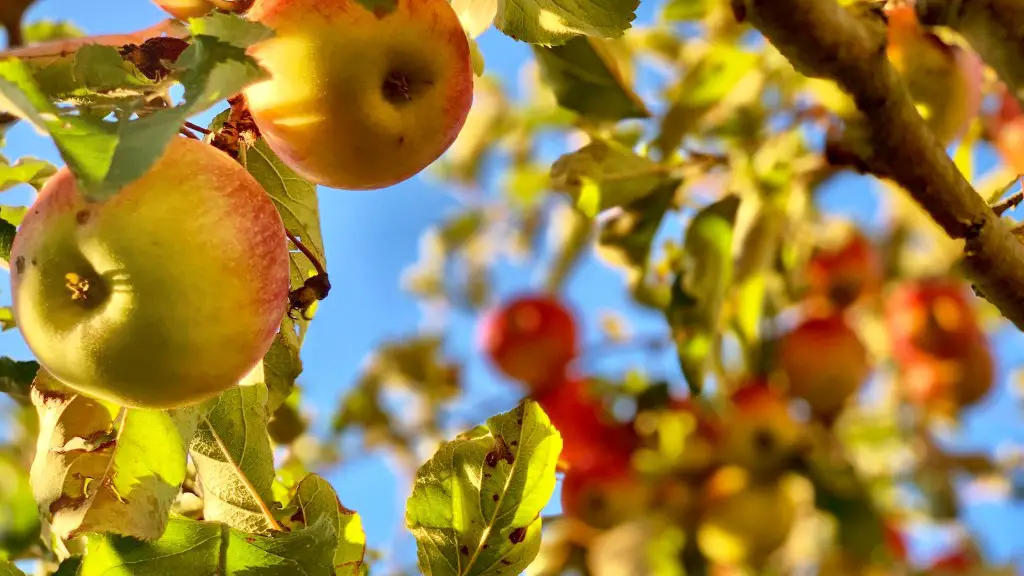When it comes to apple trees, it is best to transplant them in the fall. This is because the trees are dormant during this time and experience less stress. The steps for transplanting an apple tree are as follows:
1. Choose a location for the tree that has well-draining soil and receives plenty of sunlight.
2. Dig a hole that is twice the width of the tree’s root ball and just as deep.
3. Gently remove the tree from its current location and place it in the hole.
4. Backfill the hole with soil and water well.
5. Stake the tree if necessary and prune any damaged or broken branches.
With proper care, your apple tree will thrive in its new location.
Apple trees can be transplanted by digging a hole that is twice the width and depth of the tree’s root ball. The hole should be filled with a mix of well-draining soil and compost. The tree should be placed in the hole so that the roots are not crowded and the trunk is straight. The hole should be filled with soil, and the tree should be watered deeply.
Can you relocate an apple tree?
While fruit trees can withstand planting throughout the year, the best time of year to transplant fruit trees is in the dormancy state to early spring before their active growth period. Fruit trees should never be transplanted when they have already started developing buds or during the peak growing season. This is because transplanting during these times can shock the tree and cause it to go into dormancy, which can stunt its growth or even kill the tree.
Apple trees can be transplanted in early spring or late fall in USDA zones 6 to 8. In areas north of zone 6, apple trees should be planted in the spring after the danger of frost is over.
How do you transplant a tree without killing it
If you’re planning to dig up a tree, it’s important to water it deeply the night before. This will soften the soil, making it easier to cut the ground and remove the tree. It will also help to hydrate the tree, making it less prone to transplant shock.
The best way to transplant fruit trees is to do it in early spring before their active growth phase, or during the cold season when the tree is dormant. Dig up established trees with care to avoid severing important roots.
What month do you transplant apple trees?
Bare-root plants are best planted from late autumn to early spring, while containerised plants can be planted at any time of year (though winter is preferred). This ensures that the plants have the best chance to establish themselves before the hot summer weather arrives.
Transplant shock is tough for trees, but they can recover if the symptoms are caught early and the proper recovery techniques are used. Trees that are dropping leaves is a sign of shock. Once the symptoms are identified, the tree can be helped to recover by using the proper techniques and giving it time to repair.
How do you move an apple tree without killing it?
When moving a tree, it is important to have a ball of moist soil still covering the root system. This will give the tree the best chance of success. If the ground is dry, thoroughly water a couple of days before the planned move. Using a spade, dig a trench around the tree then cut beneath the roots and around the bottom of the soil ball.
The development of root systems is extremely rapid, reaching a maximum depth of 88 feet and a lateral spread of 12 feet the first year, 148 feet and 212 feet the second year, and 294 feet the third year.
How do you prevent tree transplant shock
When planting a new tree, it is important to select a variety that is native to the region. This will help to prevent transplant shock. Additionally, be sure to plant the tree at the proper depth. Water is a key ingredient for new trees to thrive, so be sure to water regularly.
Planting a tree is a great way to add to the beauty of your landscape and help the environment. However, it is important to realize that it can take a tree some time to adjust to its new surroundings and may experience some stress symptoms. In most cases, it takes a year or so for trees to shake off transplant shock, but occasionally it can even take up to five years for them to fully recover. So, be patient and give your new tree some time to adjust and you will be rewarded with years of enjoyment.
How do you prepare a tree for transplanting?
When transplanting a tree, it is important to prune the roots around the root ball of the plant to be moved. Prune 8 to 12 inches deep, three to six months before transplanting. New roots will form from the severed roots.
When pruning the roots of a tree, it is important to take several factors into consideration. First, the tree must be well-watered before any pruning is done. This will help to avoid shock and stress to the plant. Next, you will need to assess how much of the roots need to be pruned. too much pruning can damage the tree, so it is important to only remove the necessary amount. After determining how much to remove, dig a trench around the root ball. This will help to loosen the roots and make transplanting easier. Finally, replace the soil around the pruned roots and water the tree well. Choose a new site for the tree that is suitable and has good drainage. transplanting the tree.
Should you water a tree before transplanting
When you are transplanting a tree, you will want to make the process as quick as possible to protect the roots. It is important to water the tree 24 hours before the transplant. This will help to get the roots fully soaked so the entire tree is well-hydrated.
Fertilization at the time of planting is generally not recommended. It is ineffective until the root system has a chance to reestablish. It is usually advisable to wait two or three years before applying fertilizer, and then it is recommended to get a soil test first.
Should I water a transplanted tree?
It is very important to water a newly transplanted tree regularly, especially during hot and dry weather. The tree will need regular irrigation for several years. This is because a small, young tree has a small root ball with limited capacity to absorb water.
It is important to water your plants regularly, especially when they are first getting started. Water them at planting time, and then 1-2 weeks after planting, water them daily. 3-12 weeks after planting, water them every 2 to 3 days. After 12 weeks, water them weekly until their roots are established.
Warp Up
The best time to transplant an apple tree is in early spring, before the tree begins to leaf out.
1. Choose a location for your tree that receives full sun and has well-drained soil.
2. Carefully dig up the tree, taking care to include as much of the root ball as possible.
3. Plant the tree at the same depth it was growing at previously.
4. Water the tree well and mulch around the base to help keep the roots moist.
When transplanting an apple tree, it is important to take into account the tree’s root system. This will help to ensure that the tree is able to establish itself in its new location. Additionally, it is important to water the tree regularly and to fertilize it according to the manufacturer’s directions. By following these simple steps, you can successfully transplant an apple tree.


